Abstract
The CD8 dimer interacts with the alpha 3 domain of major histocompatibility complex class I molecules through two immunoglobulin variable-like domains. In this study a crystal structure-informed mutational analysis has been performed to identify amino acids in the CD8 alpha/alpha homodimer that are likely to be involved in binding to class I. Several key residues are situated on the top face of the dimer within loops analogous to the complementarity-determining regions (CDRs) of immunoglobulin. In addition, other important amino acids are located in the A and B beta-strands on the sides of the dimer. The potential involvement of amino acids on both the top and the side faces of the molecule is consistent with a bivalent model for the interaction between a single CD8 alpha/alpha homodimer and two class I molecules and may have important implications for signal transduction in class I-expressing cells. This study also demonstrates a role for the positive surface potential of CD8 in class I binding and complements previous work demonstrating the importance of a negatively charged loop on the alpha 3 domain of class I for CD8 alpha/alpha-class I interaction. We propose a model whereby residues located on the CDR-like loops of the CD8 homodimer interact with the alpha 3 domain of MHC class I while amino acids on the side of the molecule containing the A and B beta-strands contact the alpha 2 domain of class I.
Full text
PDF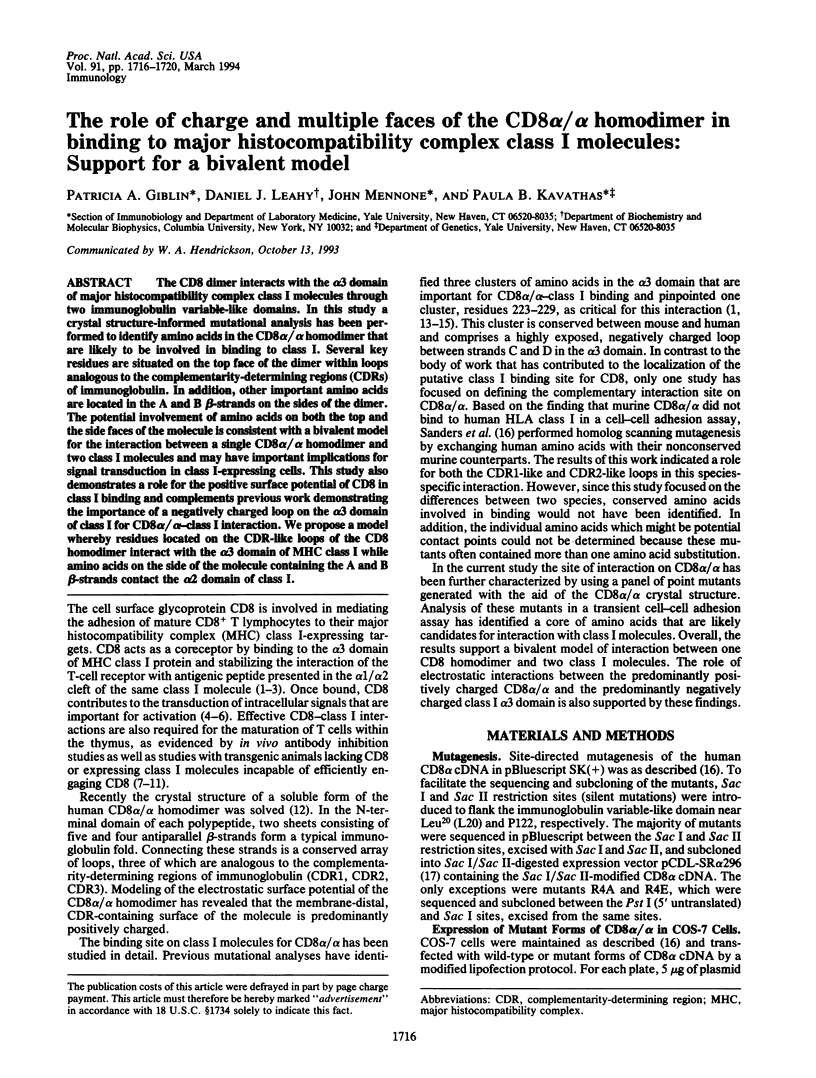
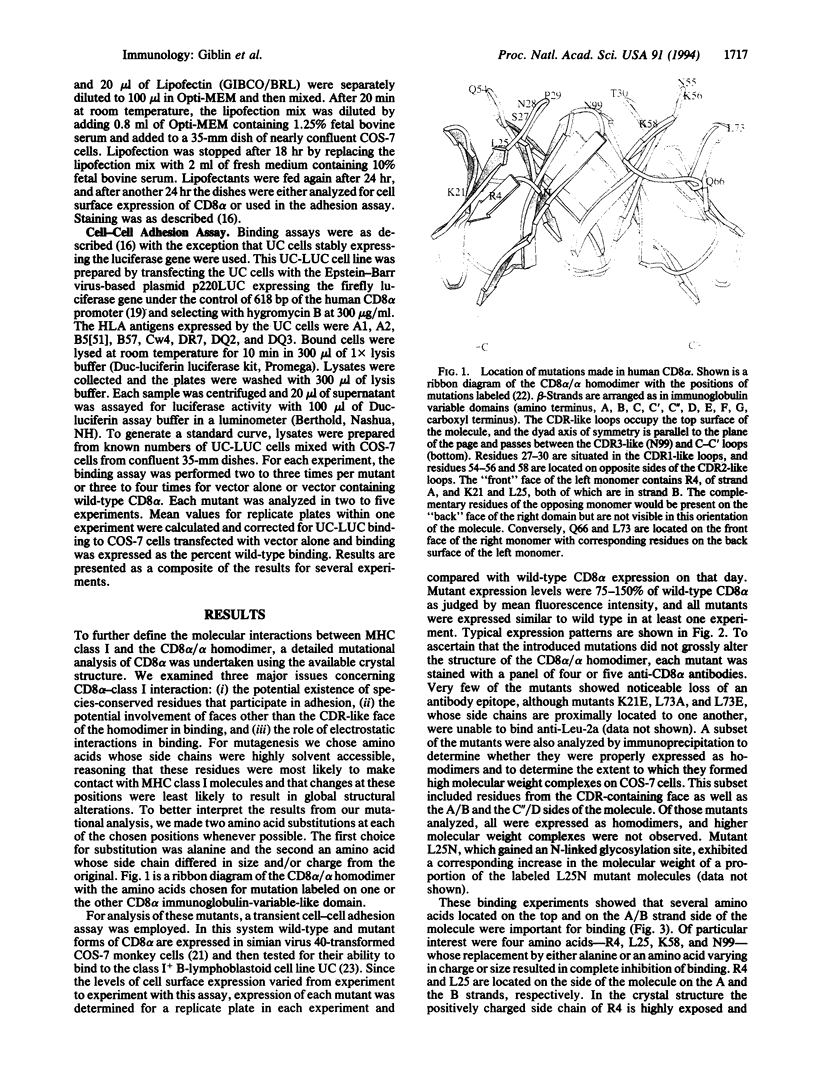
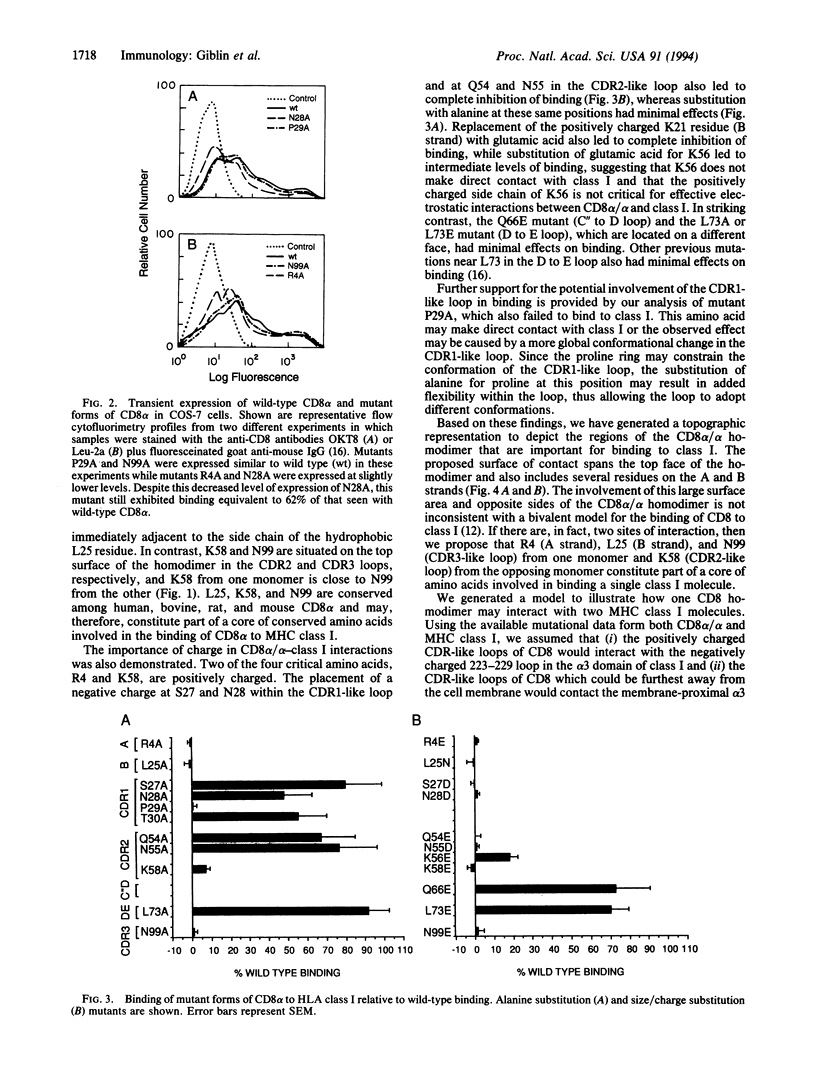
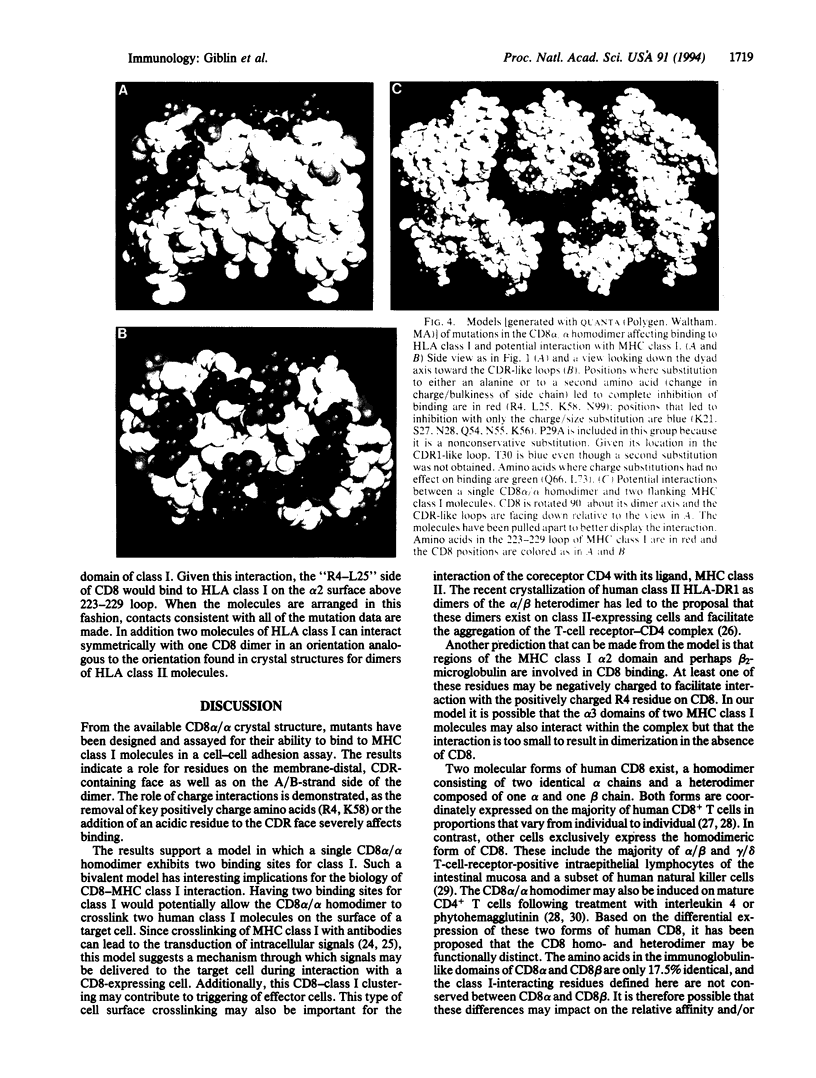
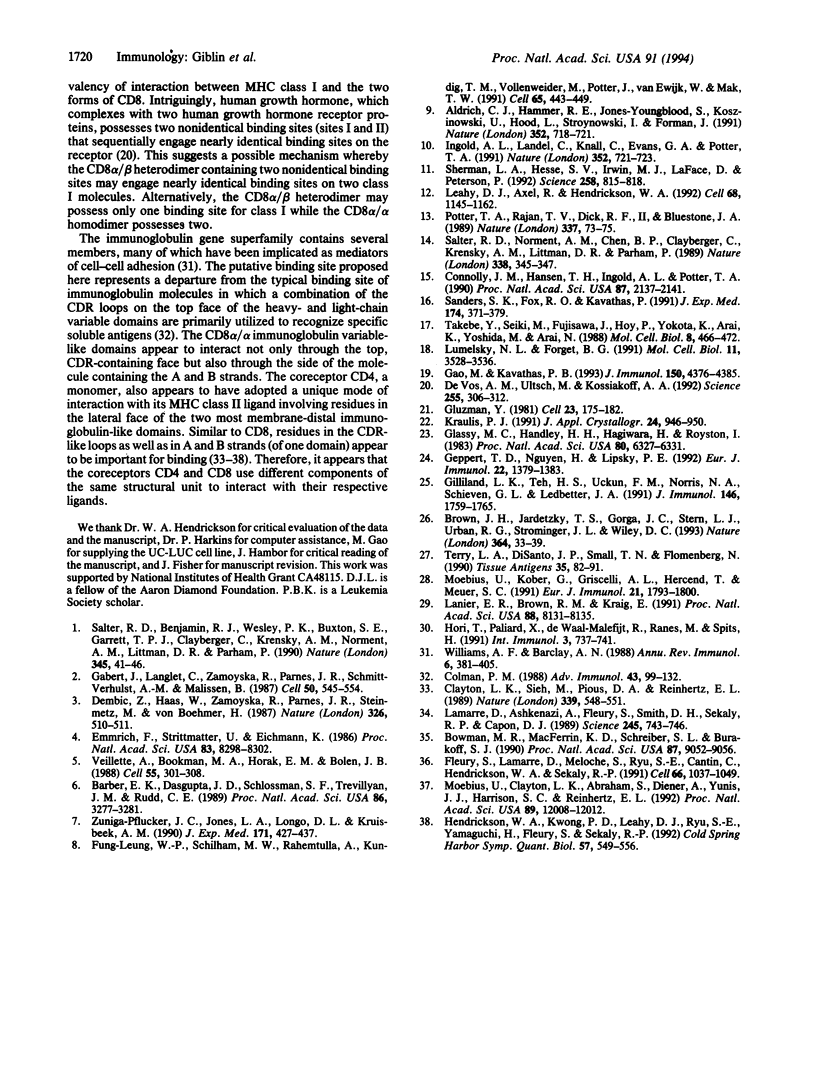
Images in this article
Selected References
These references are in PubMed. This may not be the complete list of references from this article.
- Aldrich C. J., Hammer R. E., Jones-Youngblood S., Koszinowski U., Hood L., Stroynowski I., Forman J. Negative and positive selection of antigen-specific cytotoxic T lymphocytes affected by the alpha 3 domain of MHC I molecules. Nature. 1991 Aug 22;352(6337):718–721. doi: 10.1038/352718a0. [DOI] [PubMed] [Google Scholar]
- Barber E. K., Dasgupta J. D., Schlossman S. F., Trevillyan J. M., Rudd C. E. The CD4 and CD8 antigens are coupled to a protein-tyrosine kinase (p56lck) that phosphorylates the CD3 complex. Proc Natl Acad Sci U S A. 1989 May;86(9):3277–3281. doi: 10.1073/pnas.86.9.3277. [DOI] [PMC free article] [PubMed] [Google Scholar]
- Bowman M. R., MacFerrin K. D., Schreiber S. L., Burakoff S. J. Identification and structural analysis of residues in the V1 region of CD4 involved in interaction with human immunodeficiency virus envelope glycoprotein gp120 and class II major histocompatibility complex molecules. Proc Natl Acad Sci U S A. 1990 Nov;87(22):9052–9056. doi: 10.1073/pnas.87.22.9052. [DOI] [PMC free article] [PubMed] [Google Scholar]
- Brown J. H., Jardetzky T. S., Gorga J. C., Stern L. J., Urban R. G., Strominger J. L., Wiley D. C. Three-dimensional structure of the human class II histocompatibility antigen HLA-DR1. Nature. 1993 Jul 1;364(6432):33–39. doi: 10.1038/364033a0. [DOI] [PubMed] [Google Scholar]
- Clayton L. K., Sieh M., Pious D. A., Reinherz E. L. Identification of human CD4 residues affecting class II MHC versus HIV-1 gp120 binding. Nature. 1989 Jun 15;339(6225):548–551. doi: 10.1038/339548a0. [DOI] [PubMed] [Google Scholar]
- Colman P. M. Structure of antibody-antigen complexes: implications for immune recognition. Adv Immunol. 1988;43:99–132. doi: 10.1016/s0065-2776(08)60364-8. [DOI] [PubMed] [Google Scholar]
- Connolly J. M., Hansen T. H., Ingold A. L., Potter T. A. Recognition by CD8 on cytotoxic T lymphocytes is ablated by several substitutions in the class I alpha 3 domain: CD8 and the T-cell receptor recognize the same class I molecule. Proc Natl Acad Sci U S A. 1990 Mar;87(6):2137–2141. doi: 10.1073/pnas.87.6.2137. [DOI] [PMC free article] [PubMed] [Google Scholar]
- Dembić Z., Haas W., Zamoyska R., Parnes J., Steinmetz M., von Boehmer H. Transfection of the CD8 gene enhances T-cell recognition. Nature. 1987 Apr 2;326(6112):510–511. doi: 10.1038/326510a0. [DOI] [PubMed] [Google Scholar]
- Emmrich F., Strittmatter U., Eichmann K. Synergism in the activation of human CD8 T cells by cross-linking the T-cell receptor complex with the CD8 differentiation antigen. Proc Natl Acad Sci U S A. 1986 Nov;83(21):8298–8302. doi: 10.1073/pnas.83.21.8298. [DOI] [PMC free article] [PubMed] [Google Scholar]
- Fleury S., Lamarre D., Meloche S., Ryu S. E., Cantin C., Hendrickson W. A., Sekaly R. P. Mutational analysis of the interaction between CD4 and class II MHC: class II antigens contact CD4 on a surface opposite the gp120-binding site. Cell. 1991 Sep 6;66(5):1037–1049. doi: 10.1016/0092-8674(91)90447-7. [DOI] [PubMed] [Google Scholar]
- Fung-Leung W. P., Schilham M. W., Rahemtulla A., Kündig T. M., Vollenweider M., Potter J., van Ewijk W., Mak T. W. CD8 is needed for development of cytotoxic T cells but not helper T cells. Cell. 1991 May 3;65(3):443–449. doi: 10.1016/0092-8674(91)90462-8. [DOI] [PubMed] [Google Scholar]
- Gabert J., Langlet C., Zamoyska R., Parnes J. R., Schmitt-Verhulst A. M., Malissen B. Reconstitution of MHC class I specificity by transfer of the T cell receptor and Lyt-2 genes. Cell. 1987 Aug 14;50(4):545–554. doi: 10.1016/0092-8674(87)90027-4. [DOI] [PubMed] [Google Scholar]
- Gao M. H., Kavathas P. B. Functional importance of the cyclic AMP response element-like decamer motif in the CD8 alpha promoter. J Immunol. 1993 May 15;150(10):4376–4385. [PubMed] [Google Scholar]
- Geppert T. D., Nguyen H., Lipsky P. E. Engagement of class I major histocompatibility complex molecules by cell surface CD8 delivers an activation signal. Eur J Immunol. 1992 Jun;22(6):1379–1383. doi: 10.1002/eji.1830220608. [DOI] [PubMed] [Google Scholar]
- Gilliland L. K., Teh H. S., Uckun F. M., Norris N. A., Teh S. J., Schieven G. L., Ledbetter J. A. CD4 and CD8 are positive regulators of T cell receptor signal transduction in early T cell differentiation. J Immunol. 1991 Mar 15;146(6):1759–1765. [PubMed] [Google Scholar]
- Glassy M. C., Handley H. H., Hagiwara H., Royston I. UC 729-6, a human lymphoblastoid B-cell line useful for generating antibody-secreting human-human hybridomas. Proc Natl Acad Sci U S A. 1983 Oct;80(20):6327–6331. doi: 10.1073/pnas.80.20.6327. [DOI] [PMC free article] [PubMed] [Google Scholar]
- Gluzman Y. SV40-transformed simian cells support the replication of early SV40 mutants. Cell. 1981 Jan;23(1):175–182. doi: 10.1016/0092-8674(81)90282-8. [DOI] [PubMed] [Google Scholar]
- Hendrickson W. A., Kwong P. D., Leahy D. J., Ryu S. E., Yamaguchi H., Fleury S., Sékaly R. P. Structural aspects of CD4 and CD8 involvement in the cellular immune response. Cold Spring Harb Symp Quant Biol. 1992;57:549–556. doi: 10.1101/sqb.1992.057.01.060. [DOI] [PubMed] [Google Scholar]
- Hori T., Paliard X., de Waal Malefijt R., Ranes M., Spits H. Comparative analysis of CD8 expressed on mature CD4+ CD8+ T cell clones cultured with IL-4 and that on CD8+ T cell clones: implication for functional significance of CD8 beta. Int Immunol. 1991 Jul;3(7):737–741. doi: 10.1093/intimm/3.7.737. [DOI] [PubMed] [Google Scholar]
- Ingold A. L., Landel C., Knall C., Evans G. A., Potter T. A. Co-engagement of CD8 with the T cell receptor is required for negative selection. Nature. 1991 Aug 22;352(6337):721–723. doi: 10.1038/352721a0. [DOI] [PubMed] [Google Scholar]
- Lamarre D., Ashkenazi A., Fleury S., Smith D. H., Sekaly R. P., Capon D. J. The MHC-binding and gp120-binding functions of CD4 are separable. Science. 1989 Aug 18;245(4919):743–746. doi: 10.1126/science.2549633. [DOI] [PubMed] [Google Scholar]
- Lanier E. R., Brown R. M., Kraig E. Binding of thymic factors to the conserved decanucleotide promoter element of the T-cell receptor V beta gene is developmentally regulated and is absent in SCID mice. Proc Natl Acad Sci U S A. 1991 Sep 15;88(18):8131–8135. doi: 10.1073/pnas.88.18.8131. [DOI] [PMC free article] [PubMed] [Google Scholar]
- Leahy D. J., Axel R., Hendrickson W. A. Crystal structure of a soluble form of the human T cell coreceptor CD8 at 2.6 A resolution. Cell. 1992 Mar 20;68(6):1145–1162. doi: 10.1016/0092-8674(92)90085-q. [DOI] [PubMed] [Google Scholar]
- Lumelsky N. L., Forget B. G. Negative regulation of globin gene expression during megakaryocytic differentiation of a human erythroleukemic cell line. Mol Cell Biol. 1991 Jul;11(7):3528–3536. doi: 10.1128/mcb.11.7.3528. [DOI] [PMC free article] [PubMed] [Google Scholar]
- Moebius U., Clayton L. K., Abraham S., Diener A., Yunis J. J., Harrison S. C., Reinherz E. L. Human immunodeficiency virus gp120 binding C'C" ridge of CD4 domain 1 is also involved in interaction with class II major histocompatibility complex molecules. Proc Natl Acad Sci U S A. 1992 Dec 15;89(24):12008–12012. doi: 10.1073/pnas.89.24.12008. [DOI] [PMC free article] [PubMed] [Google Scholar]
- Moebius U., Kober G., Griscelli A. L., Hercend T., Meuer S. C. Expression of different CD8 isoforms on distinct human lymphocyte subpopulations. Eur J Immunol. 1991 Aug;21(8):1793–1800. doi: 10.1002/eji.1830210803. [DOI] [PubMed] [Google Scholar]
- Potter T. A., Rajan T. V., Dick R. F., 2nd, Bluestone J. A. Substitution at residue 227 of H-2 class I molecules abrogates recognition by CD8-dependent, but not CD8-independent, cytotoxic T lymphocytes. Nature. 1989 Jan 5;337(6202):73–75. doi: 10.1038/337073a0. [DOI] [PubMed] [Google Scholar]
- Salter R. D., Benjamin R. J., Wesley P. K., Buxton S. E., Garrett T. P., Clayberger C., Krensky A. M., Norment A. M., Littman D. R., Parham P. A binding site for the T-cell co-receptor CD8 on the alpha 3 domain of HLA-A2. Nature. 1990 May 3;345(6270):41–46. doi: 10.1038/345041a0. [DOI] [PubMed] [Google Scholar]
- Salter R. D., Norment A. M., Chen B. P., Clayberger C., Krensky A. M., Littman D. R., Parham P. Polymorphism in the alpha 3 domain of HLA-A molecules affects binding to CD8. Nature. 1989 Mar 23;338(6213):345–347. doi: 10.1038/338345a0. [DOI] [PubMed] [Google Scholar]
- Sanders S. K., Fox R. O., Kavathas P. Mutations in CD8 that affect interactions with HLA class I and monoclonal anti-CD8 antibodies. J Exp Med. 1991 Aug 1;174(2):371–379. doi: 10.1084/jem.174.2.371. [DOI] [PMC free article] [PubMed] [Google Scholar]
- Sherman L. A., Hesse S. V., Irwin M. J., La Face D., Peterson P. Selecting T cell receptors with high affinity for self-MHC by decreasing the contribution of CD8. Science. 1992 Oct 30;258(5083):815–818. doi: 10.1126/science.1439792. [DOI] [PubMed] [Google Scholar]
- Takebe Y., Seiki M., Fujisawa J., Hoy P., Yokota K., Arai K., Yoshida M., Arai N. SR alpha promoter: an efficient and versatile mammalian cDNA expression system composed of the simian virus 40 early promoter and the R-U5 segment of human T-cell leukemia virus type 1 long terminal repeat. Mol Cell Biol. 1988 Jan;8(1):466–472. doi: 10.1128/mcb.8.1.466. [DOI] [PMC free article] [PubMed] [Google Scholar]
- Terry L. A., DiSanto J. P., Small T. N., Flomenberg N. Differential expression and regulation of the human CD8 alpha and CD8 beta chains. Tissue Antigens. 1990 Feb;35(2):82–91. doi: 10.1111/j.1399-0039.1990.tb01761.x. [DOI] [PubMed] [Google Scholar]
- Veillette A., Bookman M. A., Horak E. M., Bolen J. B. The CD4 and CD8 T cell surface antigens are associated with the internal membrane tyrosine-protein kinase p56lck. Cell. 1988 Oct 21;55(2):301–308. doi: 10.1016/0092-8674(88)90053-0. [DOI] [PubMed] [Google Scholar]
- Williams A. F., Barclay A. N. The immunoglobulin superfamily--domains for cell surface recognition. Annu Rev Immunol. 1988;6:381–405. doi: 10.1146/annurev.iy.06.040188.002121. [DOI] [PubMed] [Google Scholar]
- Zúiga-Pflücker J. C., Jones L. A., Longo D. L., Kruisbeek A. M. CD8 is required during positive selection of CD4-/CD8+ T cells. J Exp Med. 1990 Feb 1;171(2):427–437. doi: 10.1084/jem.171.2.427. [DOI] [PMC free article] [PubMed] [Google Scholar]
- de Vos A. M., Ultsch M., Kossiakoff A. A. Human growth hormone and extracellular domain of its receptor: crystal structure of the complex. Science. 1992 Jan 17;255(5042):306–312. doi: 10.1126/science.1549776. [DOI] [PubMed] [Google Scholar]




